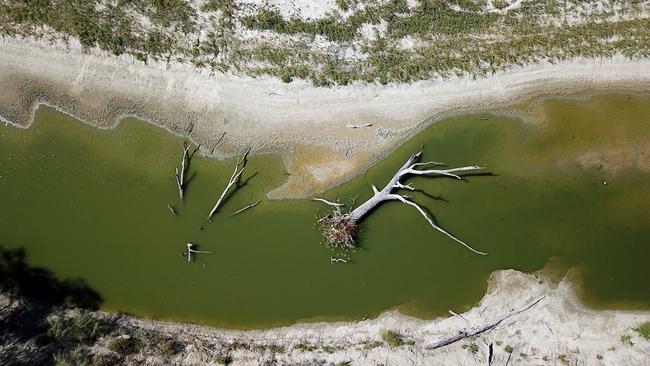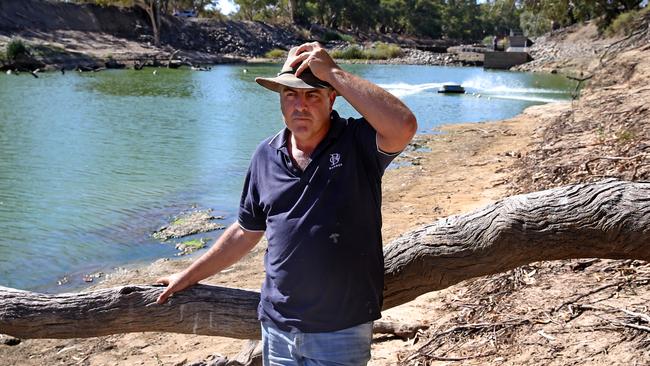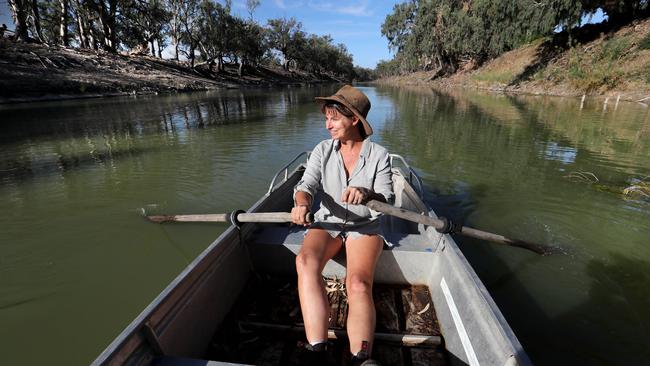The Great River Run: Murray Darling crisis tests the courage and resilience of hardiest country folk
The basic elements of an inland NSW drought are straightforward enough. First the rain stops and then, very gradually, so does everything else. This is where we stand with the Darling River now. EXCLUSIVE SPECIAL INVESTIGATION.
- Great River Run Part 2: Murray Darling’s lonely 900km dirt road
- Great River Run: Murray Darling crisis Part 1
- Great River Run: What drove Murray Darling’s early expansion
- Great River Run: Getting to the heart of a tragic treasure
The basic elements of an inland NSW drought are straightforward enough.
First the rain stops and then, very gradually, so does everything else. Crops fail, or are not planted at all.
Farms enter a holding pattern, suspending usual harvesting schedules and abandoning seasonal employment. Businesses dependent on active farms and abundant agricultural production reduce their hours and their staff numbers.

During the next stage, flora and fauna are hit. Australian trees and wildlife are among the toughest on earth, but even they will eventually fade when water is withdrawn. Finally the rivers run completely dry.
This is where we stand with the Darling River, now mostly an exceptionally wide and deep dirt path.
We’ll have a future piece specifically on the Darling as our Great River Run series continues, but today we’re looking at the broader issue of the inland NSW drought.

From the outset, it is important to understand that drought is not an abnormal event in this area or indeed throughout much of the nation.
As Menindee local Graeme McCrabb puts it: “We live in a country of drought where it rains now and again.”
FAMILIAR FOE
So drought is to inland NSW as snowfall is to Europe or the northern US, although early European settlers struggled for a time to fully comprehend how remarkably punishing our dry weather could sometimes be.

Some even believed traditional European farming practices may have had a role in provoking drought.
“Explorers and squatters were well aware of the incidence of droughts along the Darling. Unfortunately, some also held an unfailing belief that improving the land could somehow improve pastoral opportunities,” the late Len Hippisley, a third-generation farmer and bush historian, wrote in 2002.

“When serious drought gripped the catchment in the 1890s, there was widespread apprehension that European grazing practices may have caused the droughts.
“We now know that while grazing did not cause the droughts, neither did droughts cause land degradation.”
Down in Pooncarie, a tiny village of fewer than 200 people between Wentworth and Menindee in the state’s southwest, lifelong farmer Rachel Strachan considers the social impact of what she says is a “very different” drought.
“Usually we’ll have a lack of water but some feed in the lots, or we’ll have some water but no feed,” she says. “This time we’re out of both.”

The knock-on effects of these shortages is felt in everyday life. “Little things that you might buy without giving it a second thought … now we think about it and we don’t buy,” Strachan says.
“We’re not spending money. Nobody is. Instead of going out to the Friday night meat tray raffles, we don’t drive the 60km into town.”
LEFT IN TEARS
Strachan also notes another difference between the current drought and previous ones: “Maybe it’s because I grew up here in the 1970s, when there were only two TV stations, but I think things are harder now on the kids. There’s just so much information and it’s right in their faces.”

Confronted by online images of dry rivers and social media commentary declaring water would never return, Strachan’s 11-year-old daughter burst into tears: “She was distressed because she thought we wouldn’t be able to water our horses.”
Nine hours north, in Bourke, Luke Moon is connected to Strachan by their shared worry over the belting being handed to towns and farmers.
Two years ago, when he took over as licensee of the Port of Bourke Hotel, his town had around 3000 residents. Now the number is down to 1500. “Businesses are going broke, one after the other,” he says. “People are leaving the area to find work. How do we get workers to come back once the rain returns?”
It’s a good question. Meanwhile, employers are forced to fly workers in for what jobs are available, further eating into scant profits.
FORTITUDE
Moon is an inventive bloke, and in order to raise charity cash for businesses and farmers he’s enlisted the pub’s head chef Shayne Barwick to attempt a world record. If all goes to plan, Barwick will claim a new mark for the longest continual playing of pool. The current record stands at 105 hours and 22 minutes. Moon believes his chef can slam it, having previously established a record for playing lawn bowls continuously.
And then the wait will go on for rain and life. “When it rains, the response is so quick,” marvels Strachan at her Pooncarie property. “The resilience of nature is incredible.”
So is the resilience of all those people riding out this drought. If human courage were water, the inland would be an ocean.
Originally published as The Great River Run: Murray Darling crisis tests the courage and resilience of hardiest country folk


